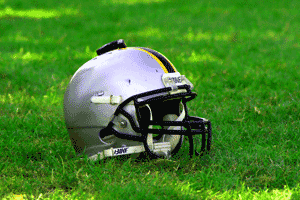 In an effort to provide full disclosure I must begin by telling a story. Five years ago, I was attending a little league football tryout as an athletic trainer for my sons' teams. I had one son trying out for a 1st grade team and another for a 4th grade team. My wife was speaking with a sizable group of mothers who were all concerned for their children's welfare.
In an effort to provide full disclosure I must begin by telling a story. Five years ago, I was attending a little league football tryout as an athletic trainer for my sons' teams. I had one son trying out for a 1st grade team and another for a 4th grade team. My wife was speaking with a sizable group of mothers who were all concerned for their children's welfare.
In an effort to assuage the women's fears, my wife called me over to explain how safe youth football is to play. As I have published an article in a sports medicine journal on the subject, I was happy to oblige. While in the middle of my speech from behind came a shout, "Dr. Adickes, I think we have a broken arm!"
Indeed an 8-year-old boy had fallen awkwardly in a non-contact drill and fractured his wrist. It is important to note that this event is the exception and not the rule. Trying to convince those mothers of that was next to impossible with my foot in my mouth.
Injuries in little league football are infrequent and when they do occur they are usually minor. Contusions, sprains and strains account for the bulk of all injuries. Prior to 4th grade very few injuries occur and, as you might expect, as kids grow and become stronger and faster, the incidence increases.
It is interesting to note that in a table of injuries for a group of 915 youth football players, ranging in age from 9-13, followed in one season, 5th, 6th and 7th graders are twice as likely to be injured as are 4th graders and that 8th graders are four times as likely to be hurt as the 9-year-old athletes. In 8th grade, kids have already begun to grow and mature and with size, speed and strength come the forces necessary to cause greater harm. Despite that fact, most injuries in this group, regardless of age, were minor and resulted in little loss of playing time. The number of injuries that occur in games is many times that found during practice sessions. This finding is not surprising to anyone who has played competitive team sports that involve collisions. With the adrenaline and emotion of game day comes an intensity and aggressiveness that result in more bumps and bruises.
Due to increased public concern over concussions The American Academy of Pediatrics (AAP) just released a 20-page review article on sport-related concussions in children and adolescents. The article is meant to provide guidance to physicians as they care for patients with concussions; 150 scientific and clinical papers on traumatic brain injury were reviewed in its preparation.
The take home information is as follows:
- Concussions are common and do not require a loss of consciousness.
- Some signs and symptoms overlap with depression, anxiety and ADHD.
- Imaging is normal with concussion (not when bleeding occurs).
- To recover athletes, must rest physically and cognitively (cognitive rest includes schoolwork, video games, computer usage, and watching TV).
- In the vast majority of cases symptoms resolve in 7-10 days.
- All pediatric patients who sustain a concussion should be evaluated by a doctor.
- Athletes should never return to play in the same game after a concussion.
- Athletes should never return to play while symptomatic at rest or with exertion.
- Long-term concussion effects are unknown.
- Benefits of medicines such as Tylenol and ibuprofen have not been established.
- If symptoms persist, retirement from all contact/collision sports may be necessary.
The breaking article from the AAP also makes it clear when to bring your child in for imaging. If your child sustained a loss of consciousness for greater than 30 seconds, has a severe headache, seizures, neurologic deficits, repeated vomiting, significant drowsiness, difficulty awakening, slurred speech, significant irritability, poor orientation to person, place or time, or neck pain they should be seen in the ER for further evaluation, including imaging.
Youth football is a relatively safe sport prior to puberty. Injury incidence increases dramatically in high school, college and professional football. At each increasing level of competition the rate of injuries nearly doubles. If you want your son to experience the joy and camaraderie or football and remain free from serious injury, have him play youth football. It is not a good idea, from an injury perspective, to wait until high school to play for the first time, but if you decide to do so draw on the words of UCLA coach John Wooden, who said, "I'd rather have a lot of talent and a little experience than a lot of experience and a little talent."
Despite the injuries and surgeries that I endured during my 23 years of playing football, I wouldn't change a thing. Football taught me lessons that make my journey though life so much easier. I credit football with teaching me about delayed gratification, teamwork, leadership, overcoming adversity, dealing with criticism and the benefits of preparation and goal setting. I would certainly have never survived medical school and residency if not for all I learned on the football field. My coaches had a monumental impact on my development as an athlete and as a person.
Dr. Mark Adickes played 9 years of professional football and is a Superbowl Champion turned Harvard-trained orthopedic surgeon. Also, he hosts Athlete 360, a sports medicine television show on Fox Sports Net.